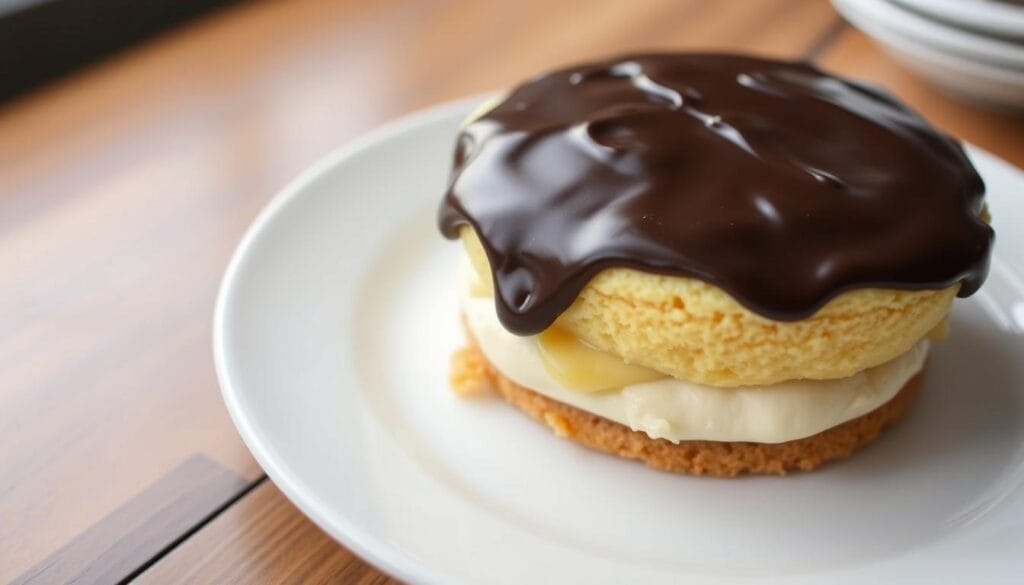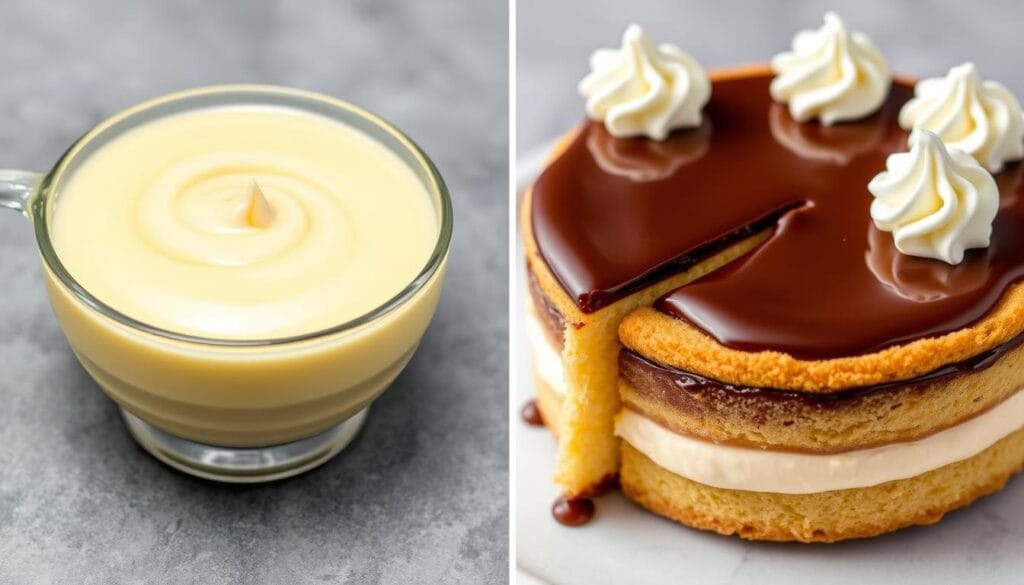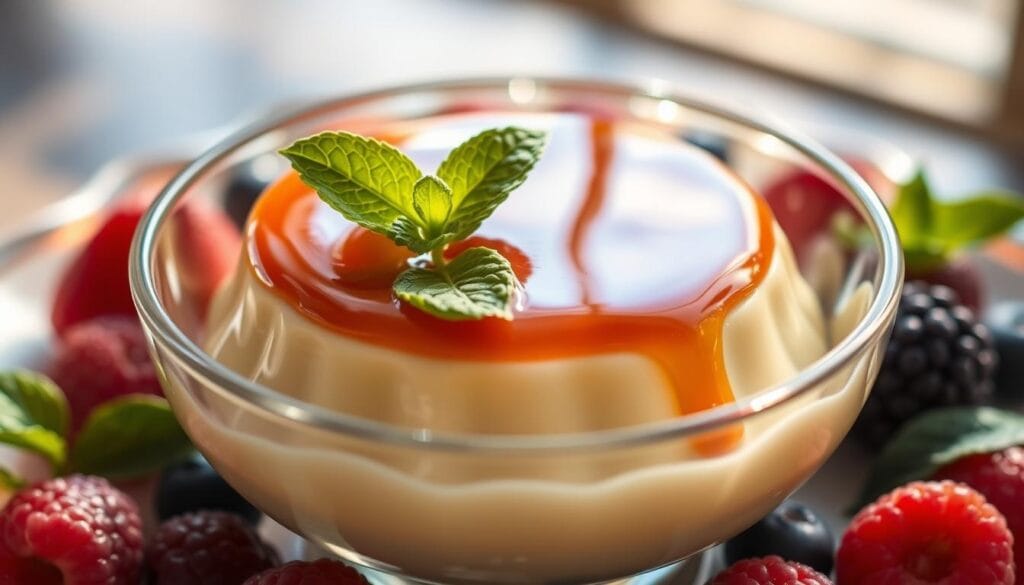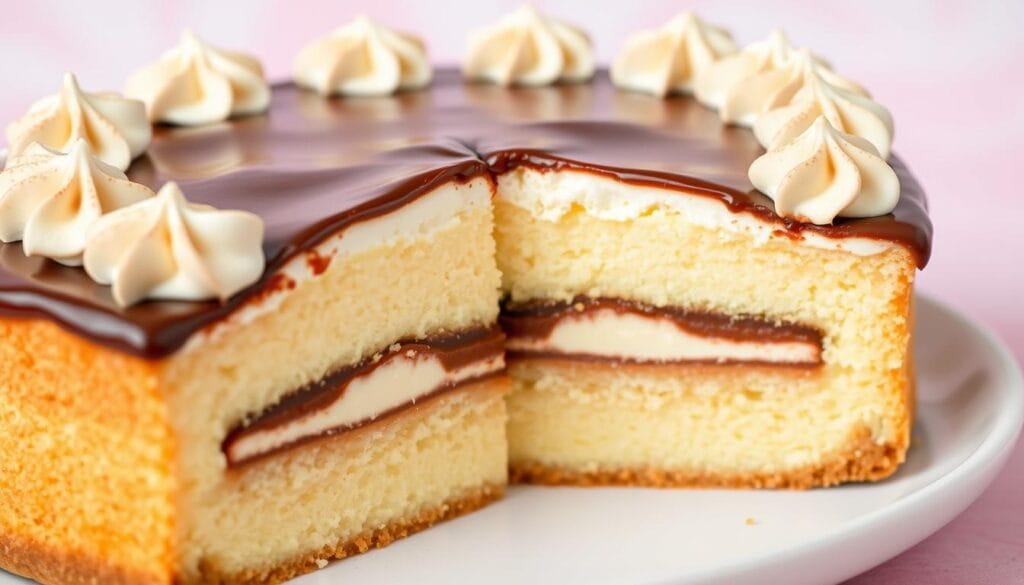I love desserts and always wondered about custard and Boston cream pie. Are they the same, or different? Let’s explore these tasty treats together.
Main Highlights :
- Custard and Boston Cream are both egg-based sauces used in pastry making, but they have distinct origins and characteristics.
- Custard is a classic French preparation, while Boston cream has its roots in American baking history.
- Boston cream pie is a layered cake with a custard-like filling, topped with chocolate ganache, whereas traditional custard is a standalone dessert.
- The unique properties and culinary applications of these two desserts set them apart, though they share some fundamental similarities.
- Understanding the nuances between custard and Boston cream can enhance your appreciation for these delightful confections.
Understanding the Origins of Custard and Boston Cream
Custard and Boston Cream have deep roots in different culinary traditions. Custard comes from French cuisine, while Boston cream has its roots in the American Northeast.
Historical Development of Custard in French Cuisine
Custard, known as crème pâtissière in French, has been a key part of French pastry for centuries. It started in the Middle Ages with Roman cooks using eggs to thicken dishes. French chefs later made it a key part of many classic French desserts.
The Birth of Boston Cream in Massachusetts
The origin of Boston cream is in the mid-19th century in Massachusetts. It’s believed to have been made at the Parker House Hotel in Boston, possibly in the 1850s. The original Boston cream had a sponge cake, custard, and chocolate glaze, a mix that changed American desserts.
Evolution Through American Baking History
Boston Cream’s fame grew, leading to many tries to make it at home in the U.S. As American baking grew, Boston cream pie adapted. It used new ingredients for a moist, buttery taste.

Today, Boston cream pie is a beloved classic. It’s the official state dessert of Massachusetts and a key part of American food history.
Are Custard and Boston Cream the Same
Custard and Boston Cream are not the same, even though they both use eggs. Custard is a versatile sauce used as a topping or filling. Boston cream, on the other hand, is a thicker filling for Boston cream pie.
Custard is made by whisking egg yolks, milk, and sugar together. Then, it’s gently cooked until thick. Boston cream, however, uses cornstarch, making it different from Bavarian cream, which uses heavy cream and gelatin.
Boston cream is made to be a cake filling. It’s silkier and smoother than Bavarian cream. Boston Cream has its roots in the Parker House Hotel in Boston in the 1850s. Custard, on the other hand, has a long history in French cuisine.
| Custard | Boston Cream |
|---|---|
| Versatile dessert sauce | Specific cake filling |
| Made with egg yolks, milk, and sugar | Made with cornstarch |
| The richer, thicker texture | Silkier, smoother texture |
| Long history in French cuisine | Originated in Boston in the 1850s |
In summary, custard and Boston cream are egg-based fillings but different. They have unique origins, ingredients, and textures. Knowing these differences helps you pick the right filling for your dishes.

Essential Components of Traditional Custard
Traditional custard, or crème pâtissière, is made from simple yet tasty ingredients. It’s a creamy sauce based on eggs. It’s great as a filling for pastries and the base for custard pudding.
Key Ingredients and Their Roles
The main parts of custard are milk, egg yolks, sugar, cornstarch, salt, and vanilla. Milk is the base, and egg yolks make it creamy. Sugar adds sweetness, and cornstarch thickens it. A bit of salt and vanilla make it taste better.
Preparation Techniques and Tips
- It’s important to cook the custard right to get the right texture. Let it bubble for a full minute to thicken well.
- Whisking constantly stops it from burning and makes it smooth. It should be thick enough to hold its shape.
- Tempering the egg yolks with hot milk is key to avoid curdling. This makes the custard smooth.
Texture and Consistency Characteristics
The custard should be creamy and thick. It should be smooth and not grainy. When used as a filling, it should keep its shape and not be runny.
| Ingredient | Purpose | Amount |
|---|---|---|
| Milk | Provides the base | 1 cup |
| Egg Yolks | Contributes to the rich, velvety texture | 4 large |
| Sugar | Sweetens the custard | 2/3 cup |
| Cornstarch | Acts as a thickening agent | 3 tablespoons |
| Salt | Enhances the overall flavor | 1/4 teaspoon |
| Vanilla Extract | Adds fragrance and aroma | 1 teaspoon |

The Unique Properties of Boston Cream
Boston cream is a special dessert filling. It’s different from custard because of its texture and how it’s made. Boston cream uses cornstarch to thicken, not eggs and milk like custard. This makes it firmer and perfect for cake fillings.
The recipe for Boston cream mixes milk, egg yolks, sugar, and cornstarch. It also adds vanilla for flavor. After cooking until thick, it cools down. This texture is great for filling Boston cream pies, adding a rich contrast to the chocolate on top.
| Ingredient | Quantity |
|---|---|
| Half & half | 1 cup |
| Egg yolks | 3 |
| Sugar | 1/2 cup |
| Cornstarch | 3 tbsp |
| Vanilla extract | 1 tsp |
Boston cream is great as a filling for many baked goods. It works well with cakes, donuts, cream puffs, and eclairs. Its creamy yet firm texture is a hit with pastry lovers and Boston cream pie fans.

Culinary Applications and Popular Desserts
Boston cream pie is a favorite in the world of baked goods. It comes from Massachusetts and has a mix of custard and chocolate. This mix has won hearts for many years. It’s not just a pie; it’s also in many other desserts, showing its lasting appeal.
Classic Boston Cream Pie
The traditional Boston cream pie is a masterpiece. It has two layers of sponge cake with a creamy custard in the middle. On top, there’s a glossy chocolate ganache.
The custard is made from milk, egg yolks, and cornstarch. It’s smooth and rich. The cake is light and airy, balancing the dessert’s flavors and textures.
Modern Adaptations and Variations
New versions of Boston cream pie have become popular. You can find Boston cream doughnuts, Boston cream cupcakes, and Boston cream trifles. These changes let bakers and chefs show off their skills and meet different tastes.
One cool twist is using a hot milk cake instead of a traditional sponge cake. This cake is lighter and softer. It’s a great choice for those who want a less rich version of Boston cream pie. Being Massachusetts’s official dessert shows its cultural importance and lasting love in American baked goods and desserts.
| Ingredient | Quantity |
|---|---|
| All-purpose flour | 1 1/2 cups (215g) |
| Baking powder | 1 1/2 teaspoon |
| Baking soda | 1/4 teaspoon |
| Granulated sugar | 1 cup (200g) |
| Salt | 1/2 teaspoon |
| Eggs | 2 large |
| Unsalted butter | 1/4 cup (56g) |
| Sunflower or canola oil | 3 tablespoons (45ml) |
| Plain yogurt | 1/4 cup (60ml) |
| Vanilla extract | 1 1/2 teaspoons (7ml) |
| Whole milk | 1/2 cup (120ml) |
The classic Boston cream pie recipe makes 10 servings. It’s a mix of rich flavors and textures. The cake, custard, and chocolate work together to make a memorable American dessert.
Texture and Consistency Differences
Desserts like custard and Boston cream can be confusing. But they are very different in texture and consistency. This makes them perfect for different kinds of desserts.
Custard, also known as crème pâtissière, is soft and pourable. It’s great for filling pastries, tarts, and doughnuts. Its creamy texture adds a rich layer to desserts. Custard gets its smoothness from egg yolks.
Boston cream, on the other hand, is thicker and more stable. Cornstarch makes it firmer. This texture is perfect for desserts like Boston cream pie. It holds its shape well against the cake.
| Custard | Boston Cream |
|---|---|
| Softer, more pourable texture | Thicker, more stable consistency |
| Reliance on egg yolks for thickening | Cornstarch used to achieve a firmer texture |
| Suitable for fillings in pastries, tarts, and doughnuts | Ideal for layering in cakes, such as Boston cream pie |
Custard and Boston’s creams have unique textures. They are perfect for different desserts. This lets bakers and dessert lovers enjoy their special qualities.
Professional Baking Techniques and Tips
Temperature control is key when baking with custards and creams. For Boston cream pie, brush cake layers with simple syrup to keep them moist. When making the custard filling, it’s important to cook it right. This ensures the cornstarch works well and the starch doesn’t break down.
Temperature Control Methods
Constant whisking is vital to avoid scorching and get the custard to the right thickness. Using a digital food thermometer is also recommended. It helps reach the perfect temperature of about 185°F (85°C).
Common Troubleshooting Solutions
- If the custard won’t thicken, try cooking it a bit longer and at a higher temperature.
- For a smooth texture, strain the custard through a fine-mesh sieve before chilling.
- To stop skin from forming on the custard, press plastic wrap right onto the surface.
By learning these advanced techniques, bakers can make their baked goods, bakery items, and pastry fillings even better. They’ll get amazing flavors and textures.
Cultural Impact and Regional Variations
The American dessert, Boston cream pie, has become a favorite everywhere. It has inspired many regional desserts and new creations. This shows how loved and adaptable this custard dessert is.
Betty Crocker’s 1958 boxed mixes made Boston cream pie easy to make at home. This helped it become a big hit across the country. Now, places like the Southeast and West Coast have their cream-filled pastries. But Boston cream pie is still most loved in the Northeast.
This dessert has also made waves globally, inspiring new pastry ideas. Its custard and chocolate glaze have made it a worldwide favorite. It celebrates the variety of American desserts.
In the 1950s, the Banana Cream Pie was a hit with the US Armed Services. During the Great Depression, Vinegar Pie helped families survive. These desserts show the creativity and strength of American bakers.
As food trends change, Boston cream pie and other regional desserts will keep winning hearts. They will keep inspiring people, both at home and around the world. They are key parts of the American dessert tradition.
Conclusion
Custard and Boston Cream are both egg-based desserts, but they are different. Custard is a versatile base for many desserts. Boston cream is special for Boston cream pie and similar treats.
Custard is creamy and can be used in many ways. It’s loved in both French and American cooking. Boston cream, with its chocolate topping, is a favorite in America.
Enjoying custard or Boston cream can be a special treat. Knowing the differences between them makes these desserts even more enjoyable. It shows how rich and varied custard-based sweets are in American food.
FAQ
What is the difference between custard and Boston cream?
Custard and Boston Cream are both egg-based desserts. But they are not the same. Custard is a versatile sauce, while Boston cream is a thicker filling for cakes.
Boston cream uses cornstarch, unlike Bavarian cream which uses heavy cream and gelatin. This makes Boston cream perfect for cake fillings.
What are the key ingredients in traditional custard?
Custard, or crème pâtissière, has milk, egg yolks, sugar, cornstarch, salt, and vanilla. Cornstarch thickens it. Cooking it until it bubbles for a minute is key for the right texture.
How is Boston cream made?
Boston cream uses cornstarch for a firmer texture. It’s made with milk, egg yolks, sugar, cornstarch, and vanilla. It’s cooked until thick and then cooled.
What is the classic Boston cream pie?
The classic Boston cream pie has two sponge cake layers. They’re filled with vanilla custard and topped with chocolate ganache. Now, you can find Boston cream in doughnuts, cupcakes, and trifles too.
How do the textures of custard and Boston cream differ?
Custard is softer and pourable, great for many desserts. Boston cream is thicker, perfect for cake fillings. Cornstarch makes Boston cream firmer, unlike custard which relies on egg proteins.
What are some professional baking techniques for working with custards and creams?
Bakers stress the importance of temperature control. For Boston cream pie, they brush the cake with simple syrup. This keeps it moist.
When making custard, it’s vital to cook it right. This activates cornstarch and stops enzymes from breaking it down. Always whisk constantly to avoid scorching and ensure it thickens correctly.

